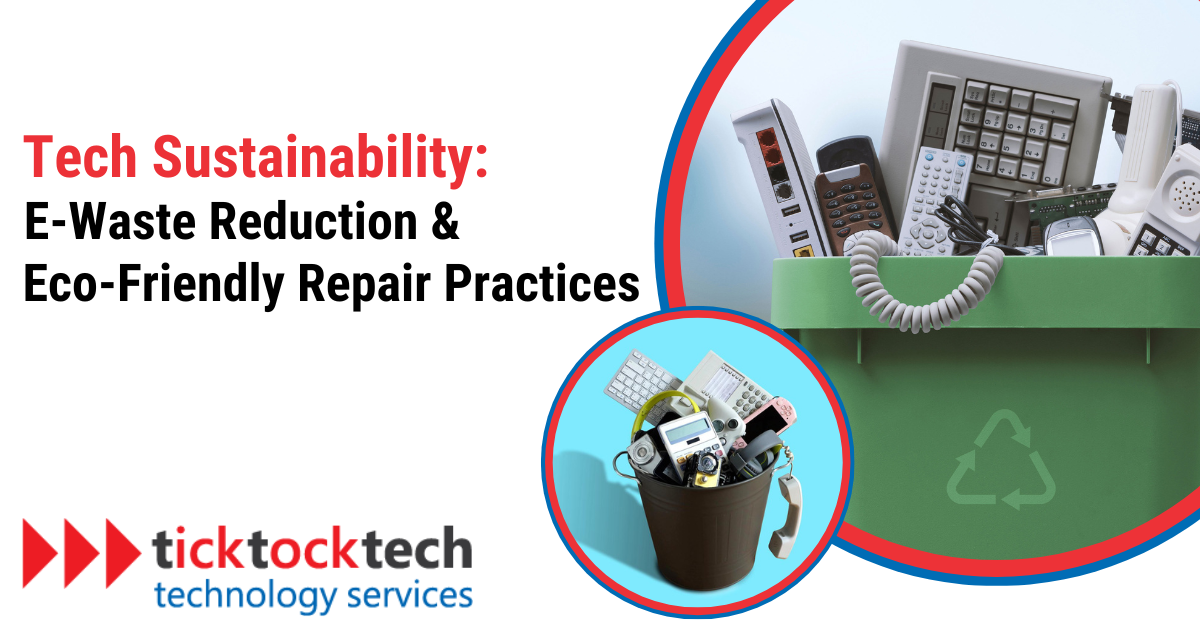E-waste, or electronic waste, refers to disposed electronic devices and equipment that are no longer needed or wanted. The huge amount of e-waste created worldwide causes big environmental and health problems. According to the World Health Organization, the world generated 53.6 million metric tons of e-waste in 2019, with only 17.4% being properly recycled. The remainder often ends up in incinerators or improperly managed dumps.
Fortunately, there are ways to reduce e-waste and promote sustainability in the tech industry. One approach is to adopt eco-friendly repair practices that extend the life of electronic devices. This can reduce the demand for new devices, reducing the environmental impact of production and disposal. In this guide, we will explore the concept of e-waste sustainability and provide practical tips for reducing your e-waste footprint.
What is E-waste Sustainability?
E-waste sustainability refers to the responsible management and reduction of electronic waste to protect our environment and health. As technology rapidly advances, the lifespan of electronic devices shortens, leading to increased electronic waste. This waste contains harmful substances that can damage the environment and pose health risks when not disposed of properly.
Sustainable e-waste management is crucial for reducing environmental harm and health risks. It addresses issues from improper disposal by promoting responsible recycling of electronics and their components. Additionally, it plays a key role in decreasing emissions and enhancing a company’s reputation through committed corporate social responsibility (CSR) practices.
What are the Sustainable Methods for E-waste Management?
Sustainable methods for e-waste management involve four strategies, each with its unique approach to reducing the environmental impact of electronic waste. Here are some of the most effective methods:
1. Reduce
The best strategy to tackle e-waste is to decrease its creation. Encouraging a mindset of “buy less, use longer” among consumers and advocating for the production of long-lasting and repairable electronics can significantly lower e-waste volumes. Additionally, manufacturers should prioritize eco-design by creating products that are simpler to disassemble, repair, and upgrade, thereby prolonging their life.
2. Consumer Education and Awareness
Informing consumers about the impact of e-waste and how to properly handle electronic disposals will improve e-waste management. Programs that educate on the importance of recycling and the dangers of improper disposal can motivate responsible consumer behavior.
3. Reuse
Sustaining the functionality of electronic devices through reuse is a key sustainable practice. Companies can set up programs to refurbish and repurpose electronics, providing them to those in need. Furthermore, contributing to e-waste recycling programs helps reduce waste and provides technology access to underserved populations.
4. Recycle
Recycling is a crucial element of sustainable e-waste management. Developing effective recycling systems allows for the recovery of valuable materials from old devices, reducing the environmental burden of extracting new raw materials. Also, working with certified e-waste recyclers guarantees that electronics are processed safely in compliance with environmental and data security regulations.
Why is Sustainable E-waste Management Important?
Reducing e-waste offers numerous benefits. Recycling electronics prevents harmful substances from polluting landfills and potentially contaminating our air, water, and soil. Professional e-waste recyclers dismantle these devices using eco-friendly methods, often repairing them for extended use.

Data security is another critical aspect. Electronic devices often contain sensitive information that requires careful handling to prevent data breaches. Partnering with certified e-waste recyclers ensures that all personal data is thoroughly destroyed, protecting against information leaks.
Furthermore, e-waste management provides an opportunity to educate the public, particularly children, about the importance of sustainability and environmental responsibility. Engaging students and communities in e-waste projects can help build good recycling habits and promote a culture of sustainability.
Best Strategies for Effective E-waste Management
Here are the top strategies for effective e-waste management:
1. Understanding the Impact of E-Waste
Electronic waste contains harmful materials like lead, mercury, and cadmium, which can harm soil, water, and air if not managed correctly. Effective e-waste management involves careful handling, recycling, and disposal to prevent environmental contamination and protect human health and ecosystems.
2. Industry Collaboration and Extended Producer Responsibility (EPR)
Governments, manufacturers, retailers, and consumers need to work together to develop robust e-waste management policies. Extended Producer Responsibility (EPR) is crucial; it requires manufacturers to manage the lifecycle of their products, including disposal and recycling.
3. Raising Awareness and Educating the Public
Educating people and companies about the effects of e-waste is critical. Awareness campaigns can teach the public about the importance of proper e-waste disposal and recycling benefits. Working with schools, community groups, and local governments to organize workshops and recycling events can boost community involvement and spread knowledge.
4. Technology Innovation and E-Waste Tracking
Innovative technologies can transform e-waste management. For example, Blockchain can track e-waste, ensuring it is handled and recycled correctly. New recycling technologies, such as automated sorting and eco-friendly extraction methods, can improve resource recovery and reduce waste.
5. Global Cooperation and Policy Advocacy
E-waste is a global issue requiring international collaboration. Joint efforts between countries, global organizations, and industry leaders are necessary to tackle e-waste effectively. Advocating for e-waste regulations and promoting international cooperation are key to comprehensive management.
Frequently Asked Questions
E-waste sustainability involves managing electronic waste to protect the environment and conserve resources by recycling and reusing electronics.
We can reduce e-waste in the environment by:
– Buying fewer and higher-quality electronics that last longer.
– Recycling old electronics responsibly using certified recyclers.
– Donating or selling still-functional devices.
– Supporting repair services to extend the life of devices.
Conclusion – How to Minimize E-waste and Adopt Sustainable Solutions
Sustainable e-waste management is crucial for protecting the environment and promoting a healthier future. By adopting the practices of reducing, reusing, and recycling electronics, we can lessen the negative impacts of e-waste. Through joint efforts, educational initiatives, technological improvements, and worldwide collaboration, we can reduce emissions and conserve natural resources.

